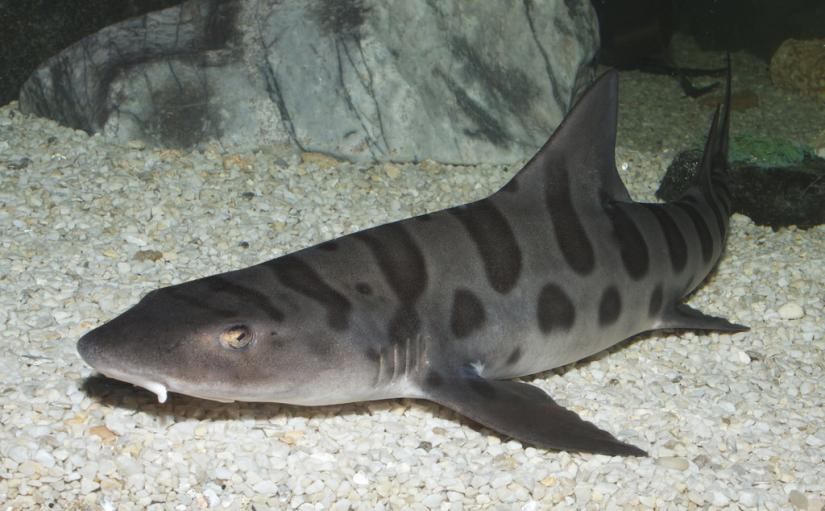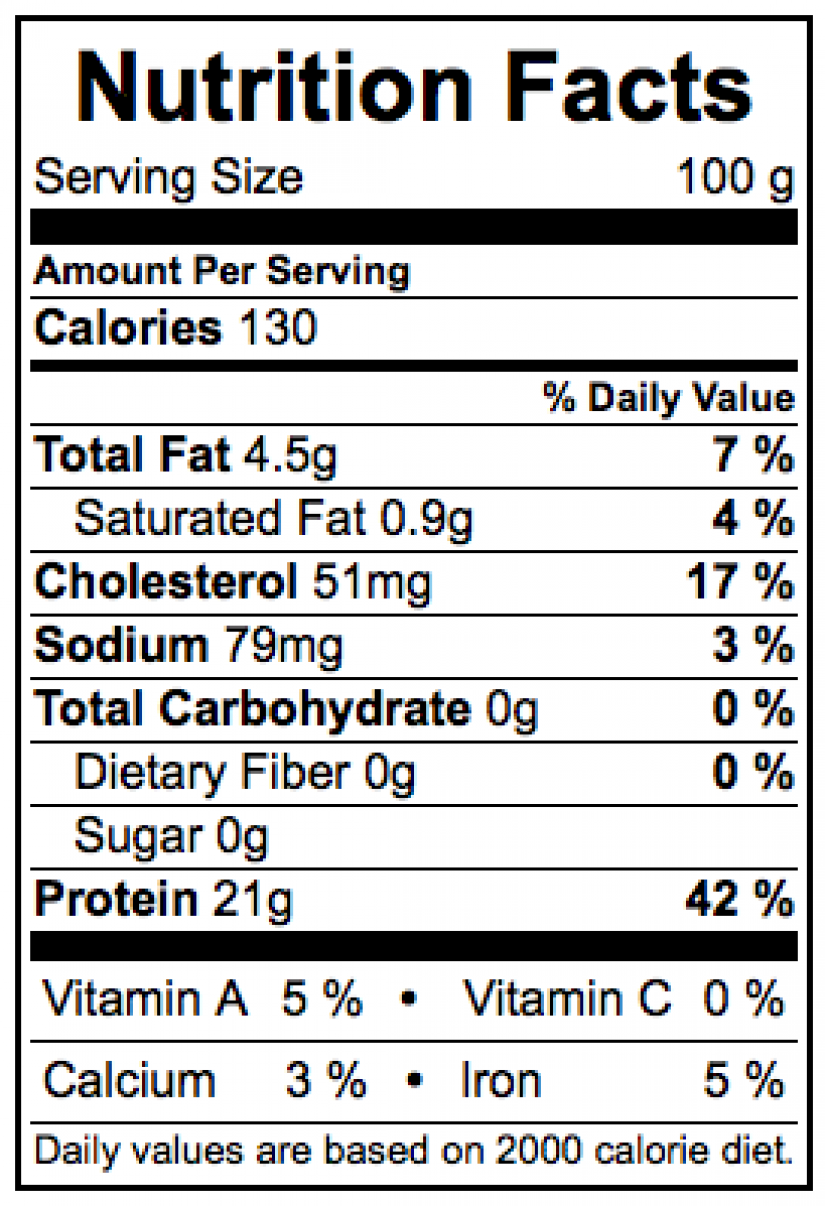Leopard Shark
Triakis semifasciata
The Science
THE SCIENCE
This shark is ovoviviparous, which means that the eggs develop and hatch inside the female and she gives birth to live babies.

Taxonomic description
- Slender bodied with a pair each of triangular dorsal fins and pectoral fins; distinctive dark spots and saddle-like markings on dorsal side, giving the shark its name. [1]
- Adult length ranges from 1.2-1.5 m (4-5 ft); size at birth 18-20 cm (7-8 in), and mature at 0.7-1.3 m (2-4 ft). [1]
Distribution
- Found in the Eastern Pacific, from Oregon to Baja California, Mexico, and into the Gulf of California. [1]
Life history
- Males live to at least 24 years old and females live to at least 20 years old. [1]
- Maturity for males is reached between 7-13 years and females between 10-15 years of age. [1]
- Little is know about its mating behavior, with only one documented observation of mating in the wild, 19 m from shore and in 1-3 m (3-9 ft.) depth water in La Jolla, California in August 2003. Mating is said to take place after spring birthing. [1]
- Females gives birth to 7-36 live young between March and July, peaking in April and May, after an estimated 10-12 month gestation period. [1]
Habitat
- Primarily found in water less than 18 m (60 ft) in depth but seen as deep as 83 m (273 ft). [1]
- Found year round along the open coast, particularly in kelp forests, rocky reefs, and near sandy beaches. [1]
- A nomadic active swimmer that may form schools segregated by size and sex. [1]
- Movements are tidal related, moving inshore to feed during high tide. It retreats to deeper water during low tide. [1]
- Aggregates with other elasmobranchs (e.g., bat ray, smoothhound sharks, sevengill sharks). [1]
- Opportunistic, feeds on a wide variety of primarily benthic prey but adults also eat anchovy, herring, sculpins, croakers, surfperch, rockfish, and small elasmobranches. Diet varies by location, season, and age.
- Preyed upon by other sharks, such as the sevengill shark and great white shark, and by sea lions.
The Fishery
THE FISHERY
This shark is targeted by recreational anglers, small-scale commercial fisheries, and marine aquaria collectors in ocean waters adjacent to California.
Seasonal availability
- Available year-round. [6]
Regulatory and managing authority
- Managed federally by the NOAA fisheries and, as established by the Magnuson-Stevens Act, the Pacific Fishery Management Council (PFMC) through the Pacific Coast Groundfish Fishery Management Plan (FMP). [4]
- As established by the Marine Life Management Act, the California Fish and Game Commission (CFGC) regulates the fishery in state waters, and the California Department of Fish and Wildlife (CDFW) manages this fishery. [1]
- The California Groundfish Collective combines input from the industry and government entities to inform regulatory and management measures for this fishery. [7]
Gear type
- Can be caught by gill nets, troll, longline, and hook and line. [4]
Status of the fishery
- Low numbers of this species were reported in 1986, mainly in San Francisco, due to over fishing; catch restrictions set shortly after including a size limit of 36 in (0.9 m), a catch limit of 3, as well as boating and depth laws and gear regulations. [1,4]
- Little is known about the size of the fishery and/or population relative to the size prior to 1992-1995 regulations. [1]
- Most caught and reported are recreational, non-commercial fishers. [1]
- There is currently no concern over the status of populations in California; numbers estimated to be stable with catch restrictions in place. [1]
Potential ecosystem impacts
- Regulation established in 1992 has helped populations recover in San Francisco Bay and beyond. [1]
The Seafood
THE SEAFOOD
Unlike the dark, meaty texture of most shark, this one is white and flakey!


Edible portions
- The meat is edible. [2]
Description of meat
- White, firm, juicy, and more tightly flaked than most fish. [2,8]
Culinary uses
- As a firm fish, it holds up well to grilling and frying. [2,8]
- For a Spanish shark with tomato recipe, visit Hunger Angler Gardener Cook. [8]
- For an Italian recipe for leopard shark, visit Master Tech. [9]
Nutritional information
- Nutritional information for this species could not be found, reported is mixed species of small sharks. [5]
- Good source of protein, niacin, vitamin B6, vitamin B12, omega-3 and -6 fatty acids, phosphorus, and selenium. [5]
- Nutrition values are listed in table. [5]
Toxicity report
- Because leopard shark has mercury and PCB's, it is generally recommended to eat at most one serving per week. Refer to OEHHA for regional recommendations. [3]
- Although not toxic, sharks can develop an ammonia smell and taste if handled improperly--to avoid this, gut and bleed the shark immediately after catching and put on ice. [2,8]
Seasonal availability
- Year round availability. [6]
References
[1] Smith, S. E. 2001. Leopard Shark-State of California. Web. https://nrm.dfg.ca.gov/FileHandler.ashx?DocumentID=34290. Accessed: 6 May 2017.
[2] Outdoor Chef Life. Youtube. 2020. SHARK Catch and Cook | How to Properly Harvest a Leopard Shark. Web. https://www.youtube.com/watch?v=oMFosH8J6FY. Accessed 14 Januar 2021.
[3] OEHHA, 2018. San Diego Bay. Web. https://oehha.ca.gov/advisories/san-diego-bay. Accessed 20 December 2018.
[4] Pacific Fisheries Management Council. 2016. Pacific Coast Groundfish Fishery Management Plan. Web. https://www.pcouncil.org/groundfish-fishery-management-plan-and-amendments/ . Accessed 04 June 2017.
[5] Leopard Shark.Web. https://www.nutritionvalue.org/Fish%2C_raw%2C_mixed_species%2C_shark_nu…. Accessed 21 September 2017.
[6] California Department of Fish and Wildlife. 2020. Web. 2020 California Commercial Fishing Regulations Digest. Web. https://nrm.dfg.ca.gov/FileHandler.ashx?DocumentID=175639&inline. Accessed 1 September 2020.
[7] The Nature Conservancy. 2015. The California Groundfish Collective. Web. http://www.cagroundfish.org/#our-story. Accessed 2 December 2020.
[8] Shaw, H. Hunger Angler Gardener Cook. 2018. Spanish Shark with Tomatoes. Web. https://honest-food.net/shark-recipe-tomatoes/. Accessed 14 January 2021.
[9] Harlow, J. San Francisco Chronicle. 1993. Palombo Coi Piselle. Web. https://www.masterstech-home.com/The_Kitchen/Recipes/International_Reci…. Accessed 14 January 2021.
[10] Field, M. Wikipedia. 2008. Digital image. Web. https://en.wikipedia.org/wiki/Leopard_shark#/media/File:Leopard_shark_i…. Accessed 17 February 2021.
[11] Gratwicke, B. flickr. 2012. leopard shark-Triakis semifasciata. Digital image. Web. https://flickr.com/photos/briangratwicke/6936602067. Accessed 17 February 2021.
[12] julochka. flickr. 2014. shark burger. Digital image. Web. https://flickr.com/photos/julochka/14837241807. Accessed 17 February 2021.



